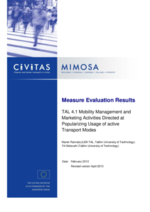Mobility management: making public transport more popular
Summary
The measure aimed at supporting the change of modal share towards active modes of transportation. Guidelines for marketing sustainable transport were developed and numerous promotional activities were carried out during the course of the project.
Implementing sustainable mobility
In total 26 promotional activities / events were carried out during the measure. Activities were applied to a range of target groups (schools, work places, individuals) and included also practical interventions such as, education and promotion to achieve a modal shift. All activities were supported by media coverage.
The main objectives of the measure are to:
- Keep current public transport users by raising their awareness of their sustainable mobility choice;
- Improve people’s satisfaction with the public transport service and improve its overall image in the urban area;
- Raise awareness of sustainable mobility concerning for instance the impact of different mobility choices such as modes of transport or car trips with only one passenger; and
- Increase the number of people who use public transport, cycle or walk and change the habits of car users.
Progress
The measure was implemented in the following stages:
• Implementing campaigns and activities , carrying out campaign satisfaction surveys. Drawing up Guidelines for marketing sustainable transport and Tallinn Public Transport Design Standard (2010 – 2012) - Activities were applied to a range of target groups and included also practical interventions. Guidelines for marketing sustainable transport and a new Tallinn Public Transport Design Standard were both drawn up within the measure but with a future perspective.
• Data collection for evaluation (2009 - 2012) – surveys before, during and after implementation of the measure activities;
• Organising awareness campaigns following a new Public Transport Design Standard (2012) - all future communications about PT will follow the visual language of the Design Standard in order to ensure consistency.
The promotion of possibilities and usefulness of active transportation modes was done through campaigns for wide variety of target groups on different events. One very important target group was children, because they are more open-minded for new ideas and besides educating a new generation of travellers it is often possible to reach their parents with ideas of sustainable transportation through them. The complete list of activities together with topics, dates, targets and numbers of participants.
One of the most influential activities with the largest target group within the measure was creation of a new Design Standard (identity) for Tallinn public transport service. The aim of creating a new Tallinn Transport identity was to change the user experience, image and communication of Tallinn public transportation to great extent, following the lead of European cities with tens of years of experience (London, Zurich, Stockholm, etc.). The mission was to make a similar impact on a very short timeline. The main keywords were: systematisation, unification, information noise reduction and standardisation, aiming at a user-friendlier and more accessible service environment. The current situation mapping process started in 2009 and there was a range of specialists involved: in-house field experts, team of design specialists, design students, external consultants, management team, production & setup team, and reflection group.
The new Tallinn Transport identity received a Design Management Europe Award 2012 on November 15th 2012 in Paredes, Portugal for best management of design in a public or non-profit organisation.
Outcomes
The main indicators for the evaluation were awareness and acceptance on particular most influential measure activities, change in general acceptance on fostering sustainable transportation and change in the modal share in Tallinn. The results were all based on large scale surveys before and after implementation of the measure and survey results from the activity “Knitting Graffiti Bus”.
The key results from the evaluation gave a good impression:
• High awareness on the measure activities - The measure activities had high level of awareness among citizens of Tallinn – 25%;
• Very high acceptance on the measure activities - The measure activities had very high level of acceptance among citizens of Tallinn – 78%;
• The overall acceptance on fostering active transportation was dropped – The acceptance has dropped by 6%, from 94% to 88% but remained very high. The measure had only partial influence on the result.
• The modal share of personal car was dropped – the share of personal car use was decreased by 1,5%, from 31,8% to 30,5%. The measure had only partial influence on the result.
The most important barriers to the measure can be considered to be:
• Political/Strategic barrier - Lack of sustainable development agenda and vision and dedicated sustainable transport marketing plan. This has lead marketing activities to be less systematic and thus to have probably smaller impact.
• Cultural barrier - Impeding cultural circumstances and lifestyle patterns. Similarly to other eastern European countries there is strong tradition and habit of considering the personal car as a prestigious mode of transport in Estonia. This has probably reduced the impact of the measure.
The most important drivers to the measure were:
• Organizational driver - Constructive partnership arrangements with other city departments and other institutions dealing with transport issues in general. This helped to implement the measure, mainly in a form of help arranging campaigns and events.
• Involvement, communication related driver - Experiences and recommendations from Dublin and other MIMOSA cities helped with ideas for implementation and evaluation. This concerned especially experience on PT campaigns and surveys.
The most important lessons for measure replication are:
• The measure is highly replicable – Several activities of the measure had been carried out by other CIVITAS cities before and several activities of the measure were repeated by other cities.
• High acceptance, low cost – Several activities of the measure have been highly accepted by citizens of Tallinn, as it came out from the surveys. The cost of marketing activities is relatively low compared to investments, thus affordable to any city.









